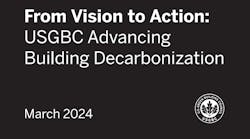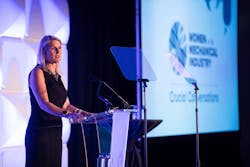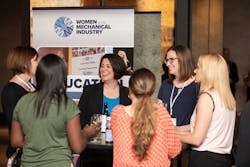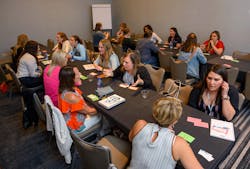In late June, more than 160 women converged in Rosemont IL, to talk about leadership, networking, recruiting and the unique challenges they face working in a traditionally male-dominated field. Women in the Mechanical Industry (WiMI) is an initiative of the Mechanical Contractors Association of America to assist women who work for members companies in a variety of roles for contractor, engineering and manufacturing firms.
The sold-out inaugural convention’s theme, “Crucial Conversations,” was evident throughout the course of the event. Col. Nicole Malachowski, a U.S. Air Force fighter pilot and the first woman to join the Air Force Thunderbirds, spoke of her conversations with herself to conquer self-doubt. Stacey Hanke presented on improving communication skills to increase influence, and a panel discussed how to engage and recruit more women into the industry. There were networking tips from J. Kelly Hoey and Steve Thomas led a session on dealing with “human weirdness.” Seven other roundtable discussions focused on various hot-button topics.
Marketing the Industry to Women
A 2014 report on women in the construction industry by the National Women’s Law Center noted that “sexual harassment and hostility, lack of mentors, and stereotyped assumptions about women’s capabilities all contribute to the problem” of women’s under-representation in this industry. Nontraditional fields such as construction and manufacturing can offer women higher wages and better benefits.
- To see WiMI's post-conference video, click here.
Women in construction also face a smaller wage gap than women overall, the report says: “The typical woman working full time in a construction and extraction occupation earned … 89 percent of the $736 per week earned by a typical man in the same occupation. By contrast, when the median weekly earnings of all full-time working men and women are compared, women typically make only 82 percent of what their male counterparts make.”
Moderated by Jon Finch, vice president of training and recruiting at Milwaukee Tool, the WiMI panel examined ways to introduce more women to into mechanical firms — whether engineering, contracting or manufacturing businesses.
Panelists came from different areas of the industry with diverse backgrounds and experiences. Ashley Martin, NIBCO’s senior vice president of sales, is the fifth generation of her family to work at the valves, fittings and flow-control manufacturer. Sarabeth Gandara, a preconstruction engineer at U.S. Engineering, is starting her career in the industry and celebrated her first work anniversary at the conference.
WiMI co-chair Kari Gormley-Huppert welcomed the inaugural crowd.
John. W. Danforth Co.’s Wendy Glauber is the general counsel and human resources director for the mechanical contracting firm. And Laura Ceja is the United Association’s recruitment and outreach coordinator with 22 years of experience as a union worker, inspector and instructor in the plumbing and pipefitting trades.
“When we say, ‘I can’t find any women who would want to do this,’ it’s a learned helplessness we have as an industry,” Ceja said. “We always say we’re the best-kept secret. Nobody knows about the opportunities in construction, what’s available to them. We don’t market ourselves. We don’t get out there and brand ourselves.”
Now a role model, herself, Malachowski (center) spoke with WiMI attendees last month about the importance of exposing young women to more diverse career examples.
It’s easier for women to see themselves in a particular career if they know of other women who are successful in that industry. Malachowski notes in her presentation that she didn’t have many role models in the Air Force when she wanted to be a fighter pilot, so she wants to be that role model for young girls today.
Promoting Role Models
So women in the mechanical industry need to put themselves in the spotlight and show young women the diverse career paths available to them in the mechanical industry — whether it’s as a mechanical engineer, a project manager, a salesperson, a plumber or HVAC tech, an estimator, a financial manager or a business owner.
Martin says that is part of the success of NIBCO’s efforts to find more women for its sales program. Dawn Ford, the manufacturer’s director of business development, is a recruiter for the sales training program, which brings in college students for 18 months of training.
“Every year we talk about what percentage of women we want in the program,” Martin noted. “It’s varied each year, but we’re getting between 20 percent and 40 percent of women in our program. I know it’s because Dawn is out there; she’s the face of the program. She’s been with us for 19 years and started in customer service and is now at the director level. What I believe is super important is the women hear her story and understand that there is a career path for them in this industry.”
Sending women apprentices to industry trade shows, conventions and other events helps recruit other women for the trades, Ceja explained. You have women in your company working as engineers, techs, project managers? Put them on the cover of your marketing brochure, she added.
Gandara said having a female industry presence on college campuses, such as at job fairs or industry competitions drives the idea home that women can contribute to the industry. “I didn’t know this industry existed,” she explained. “Then I went to an architectural competition and saw this crazy mix of the technical and the design aesthetics, and people who made that perfect combination. It was a hidden gem and I was fortunate to have been shoved in this direction.”
Two sets of roundtable discussions gave attendees two chances to talk about hot-button issues such as leadership strategies, challenges of working in a family business, advancing your career, navigating the work/life balance, men working for women in a male-dominated industry and technology.
She added that if a company doesn’t have women to send for recruitment to think about sending younger people. “It is much easier for me to walk around a career fair and approach someone who’s the same age or a little older instead of an executive in a suit,” Gandara said.
Other ideas from the audience to engage young women included construction camps, work-study or co-op programs, sending industry instructors to local schools to teach welding, pipefitting or refrigerant recovery.
Women aspiring to leadership roles also need to see successful women running successful mechanical industry businesses.
“When you’re trying to recruit women, if they see that the leadership team includes women, it’s going to make you the more attractive employer,” explained Glauber. “You just have to start. Once you have more women as part of your organization, that will attract more women, and it grows organically.”
Mentorship helps women navigate the broader challenges of being a woman in a male-dominated industry and the specific challenges of working in a particular firm. Martin said that NIBCO started a women’s group nine years ago. It began with 15 women and has grown to 48 NIBCO employees across all roles.
“We are taking the time and making it a priority to give women the opportunity for training and growth so they can continue to develop their careers with us,” she explained. “That includes tuition reimbursement if they want to go back to school for professional advancement.”
Once women join the group, a male mentor is assigned to them — there aren’t enough women in the company yet for female mentors. It is a permanent mentor relationship with a senior member of the company for feedback on how they can progress in their careers.
Mentoring doesn’t always need to be formal. Sometimes, just hanging out with women in the office at a Girls’ Night can help solidify that community of women and foster conversations about work and career, Gandara explained.
Networks: Two v. One
Hoey’s perspective on networking for women began with the differences between how men and women develop their networks. Men tend to make broad, shallow networks, while women cultivate narrow but deep networks. To be successful, women need both.
“You can’t have the careers you want without making sure you have both of those networks,” she explained. “You need people who have got your back, but you also need opportunities and that comes from that wider, broader network.”
Building relationships in an already-busy work environment takes some thought, but it doesn’t have to take up a large part of your day.
“Think of every single thing you do,” Hoey told the group, “every touchpoint you have with another human being — it could be text, it could be the person whose desk you walk by. All those interactions are opportunities to build and further a relationship, which, to me, falls in the definition of networking.
“How do you show up every single day with those around you? Because it’s the stuff that transforms careers. It’s the stuff that makes life meaningful.”
The second annual Women in the Mechanical Industry conference is set for June 15-17, 2020, in Austin TX.












